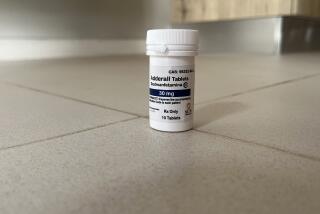At Least 2 More Palestinians Die in Gaza Clashes : Renewed Fighting Dims Prospects for Restoring Calm in Occupied Lands
Israeli troops shot and killed at least two more Palestinians in the Gaza Strip on Friday as renewed clashes following mosque services for the Muslim Sabbath dashed official hopes that calm might be returning to the territories Israel occupied after the 1967 Six-Day War.
U.N. and Palestinian sources reported that a third Arab died of army gunshot wounds suffered Wednesday.
In Jerusalem, police and para-military border guards fired tear gas at hundreds of Palestinians who demonstrated in the walled Old City after prayers at Al Aqsa Mosque, one of Islam’s holiest sites.
One elderly worshiper collapsed and died during the fracas, although police said the death was from natural causes unrelated to the tear gas.
The renewed violence occurred despite a massive Israeli military presence, which had appeared Thursday to quell the worst of the confrontations. The protests have raged for 10 straight days in Gaza and the occupied West Bank of the Jordan River.
Friday’s toll raised to at least 17 the number of Palestinians killed by Israeli gunfire in what is widely described here as the worst unrest in the occupied territories since at least 1981. Palestinian sources claim 20 dead.
The army reports about 70 Palestinians wounded since Dec. 9, including seven Friday. But U.N. and Palestinian sources put the number of wounded at around 200, mostly from gunshots.
Witnesses said demonstrators in the Gaza Strip, where the worst of the violence has been centered, were encouraged Friday by Muslim agitators broadcasting from minarets. Fundamentalists reportedly distributed leaflets in Gaza City calling for a holy war against Israel, and protesters outside the city’s El Omari Mosque chanted: “Jews, the army of the prophet Mohammed will return!”
Molotov Cocktails Thrown
The Gaza trouble began when worshipers left the noon prayer services, and it quickly spread to several towns and refugee camps in the narrow, 28-mile strip of Mediterranean seacoast. The Israeli military said troops opened fire after being attacked with stones, iron bars, and Molotov cocktails.
The worst clash was in the Shajaiye district at the southern edge of Gaza City. Palestinian sources claimed that troops fired tear gas into the neighborhood’s Al Mughrabi Mosque during services. The report could not be confirmed.
The Israeli army at first reported that two Palestinians were killed by gunfire in Shajaiye, but later said that only one had died. The Palestine Press Service, which supports the Palestine Liberation Organization, identified the victim as Maysara Al Batnaji, 20. The press service also identified seven Arabs, ranging in age from 13 to 27, as having been wounded in the clash.
Shooting at Bureij Camp
Troops also opened fire on stone throwers in the Bureij refugee camp south of Gaza City, killing Abdul Salam Fteihah, 26.
During the previous night, according to both the U.N. and Palestine Press Service, Nafez Eqteifan, 14, died of wounds he received in a clash with troops in the Deir al Balah refugee camp on Wednesday.
Protests were reported continuing in the Gaza Strip late Friday, the dwindling light punctuated with the bonfires of Arab demonstrators. Later the army said the situation was calm.
Gaza City’s Shifa hospital was surrounded by Israeli troops after soldiers broke into the compound to evict protesters and evacuate wounded Palestinians. The hospital has been a recurring focus of pitched battles between troops and protesters during the week.
“The reason there is trouble at Shifa Hospital is that people are trying to prevent the wounded from being taken to Israeli hospitals,” said Bernard Mills, director of U.N. Relief and Works Agency operations in the Gaza Strip. About 445,000 of the area’s 650,000 Palestinian residents are classified as refugees.
Mills said the Palestinians fear for the lives of their wounded friends and relatives if the army takes them away.
“It may be unjustified,” he said. “They may get better care in Israeli hospitals. But their relatives can’t go. No one can be on hand to look after them.”
Israeli Prime Minister Yitzhak Shamir vowed Friday that, despite the continuing unrest, Israel will not withdraw from the Gaza Strip as urged by some on the political left here.
“No problem can be solved by running away from it,” Shamir told reporters in Jerusalem.
“If the army is not in Gaza, it will be ruled by the PLO,” said the premier, who has blamed the violence on “Arab terror gangs.”
The clashes continued to have repercussions within Israel and on Israel’s image abroad.
Representatives of the 700,000 Israeli Arabs living within the country’s pre-1967 borders called for a one-day strike on Monday as a sign of solidarity with Palestinians on the occupied West Bank and Gaza Strip. The decision was adopted at a special conference in Shefaram, an Arab town about 15 miles east of Haifa, attended by five Israeli Arab Knesset (Parliament) members as well as heads of local councils and other officials.
Meanwhile, the government of Sweden joined a growing list of countries expressing concern about the casualties in the continuing confrontations. The ambassadors of Belgium, Denmark, and West Germany also urged, during a meeting with Cabinet Minister Ezer Weizman on Friday, that Israel do all it can to reduce the bloodshed.
More to Read
Start your day right
Sign up for Essential California for news, features and recommendations from the L.A. Times and beyond in your inbox six days a week.
You may occasionally receive promotional content from the Los Angeles Times.






